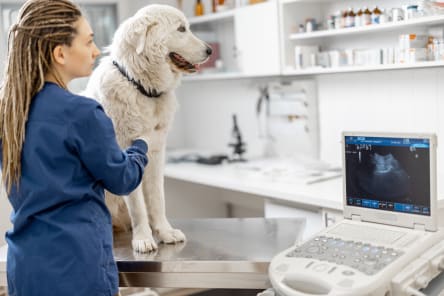What is a veterinary ultrasound?
Experienced pet owners are aware that despite their best efforts, their ambitious four-legged companions may get into things they shouldn't, or be afflicted with conditions or tumors that require treatment.
Ultrasounds transmit sound waves into an animal's body, producing an image of specific internal structures.
The technology used in ultrasounds is safe and non-invasive. Your veterinarian can also leverage it to diagnose pericardial effusion and hemoabdomen (blood surrounding the heart and in the abdomen).

Why does my pet need an ultrasound?
Your vet can use an ultrasound to see the architecture of your pet's organs to find and identify objects. With ultrasounds and other diagnostic tools, our veterinarians at Westport Veterinary Associates can accurately diagnose your pet's medical issues to effective treatment can be administered.
This tool gives us the ability to differentiate soft tissue masses, foreign bodies and fluid from one another — a task that may be difficult to achieve with a digital X-Ray. The ultrasound generates sound waves that will not be painful or harmful to your dog or cat.
Here are some examples of conditions that may need an ultrasound to detect.
Heart Conditions
If your dog or cat has a heart condition, your vet may recommend an echocardiogram to help find out whether your pet will require heart medication.
Examination of Soft Tissues
An ultrasound can be used to examine almost all of the body’s soft tissues to evaluate:
- Fetal viability and development
- Thyroid glands
- Tendons
- Ligaments
- Eyes
If abnormal tissue is discovered during the ultrasound, a vet may be able to collect tissue samples.
How are samples collected?
These methods are typically used to collect samples:
- Tri-Cut biopsies
- Ultrasound-guided fine needle aspiration
Your dog may need to be sedated with these methods. Biopsies can be performed with ultrasound imaging, in a less invasive manner than surgery would entail.
Abnormal Blood or Urine Test Results
If abnormalities are discovered in your dog’s blood or urine tests, an abdominal ultrasound may be recommended.
This can help our veterinary team see internal organs such as lymph nodes, spleen, kidneys, urinary bladder, liver or other areas to find out what’s causing the specific abnormalities.
Types of Ultrasounds
Your vet may perform one of these two types of ultrasounds:
Echocardiograms
With, echocardiograms we can closely examine the heart and the structures surrounding it, including the pericardial sac, to find out whether the heart is functioning properly. If your pet's heart is not working correctly, this can also help reveal the issue.
Usually painless, these detailed ultrasounds require numerous calculations and measurements. Your vet may recommend one if your pet is exhibiting symptoms of heart disease or was diagnosed with a heart murmur recently.
Emergency Ultrasounds
By nature, emergency situations occur suddenly and ultrasounds are usually focused on the abdomen and chest to quickly check for pneumothorax (a condition in which air or gas collects in the area around the lungs) or serious internal hemorrhaging (bleeding).
We can use emergency ultrasounds to help quickly identify and diagnose the issue, then develop an effective treatment plan.
How should I prepare for a veterinary ultrasound?
Ask your vet how you should prepare for the ultrasound. Leading up to your pet’s ultrasound appointment, you may need to withhold water and food for 8 to 12 hours, specifically for abdominal ultrasounds.
The area to be examined by your vet will be shaved, so clear images can be captured. While most pets won’t have trouble holding still during the ultrasound, some will need to be sedated.
If biopsies need to be done, your cat or dog will need a heavy sedative or short-acting anesthetic to help him or her relax during the procedure, and prevent potential complications that could impede success. Your veterinarian will let you know if this is necessary.
When will I find out the results of the examination?
Because our vets can perform an ultrasound in real time, we can see results almost immediately. In some cases, ultrasound images will be sent to a veterinary radiologist after they’re captured for more consultation. In these cases, you may need to wait a few days for the final result.
Note: The advice provided in this post is intended for informational purposes and does not constitute medical advice regarding pets. For an accurate diagnosis of your pet's condition, please make an appointment with your vet.
